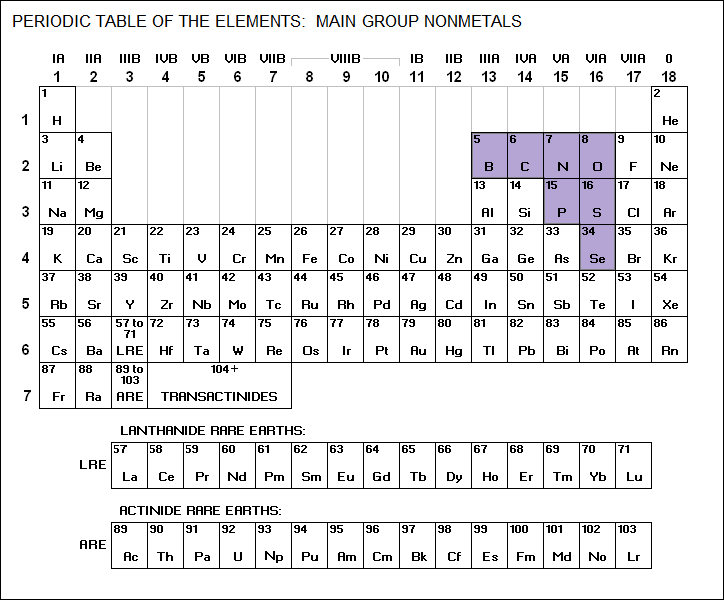
* Carbon is a member of the main group nonmetals family:

____________________________________________________________________
CARBON / C / 6
There are three forms of pure carbon: amorphous carbon (carbon
black), graphite, and diamond. Graphite consists of carbon atoms
linked together in a hexagonal grid, forming a sheet; solid
graphite consists of accumulations of such planes, and since they
slide easily over each, graphite is soft. Diamond results from
graphite kept under long-term pressure; the bonds form an extremely
strong three-dimensional lattice, and so diamond is one of the
hardest substances known.
Most (99%) of the carbon found in nature is C<12/6>, with the
remainder mostly C<13/6>. They are both stable, but traces of
radioactive C<14/6>, with a half-life of 5,730 years, can also be
found.
atomic weight: 12.0107
abundance: 15th
density: 1.8 to 2.1 gm/cc (amorphous carbon)
density: 1.9 to 2.3 gm/cc (graphite)
density: 3.5 gm/cc (diamond)
melting point: 3,560 C (graphite); diamond burns at 800 C
boiling point: 4,200 C (graphite)
valence: 2 3 <4>
____________________________________________________________________
The "CO3--" group is known as "carbonate", while the "C2H3O2-" group is known as "acetate".
Graphite is used in pencil leads, as a lubricant, and for industrial electrodes. Diamond is of course used in jewelry, and also as an industrial abrasive. Synthetic diamond technology has advanced to the point where diamond may become a very common industrial or even commercial material -- diamond coatings for ever-sharp knives and razors, for example.
Some classes of gas or liquid filter systems are based on finely granulated carbon or "activated carbon". Activated carbon for gas filter systems is obtained from coconut or other nut shells, ground up and "cooked" with steam or carbon dioxide at a temperature of about 100 degrees Celsius. The activated carbon granules are highly porous, giving them a large surface area to provide adsorption. Activated carbon for liquid filtration is similarly derived from wood, peat, or coal; this type of activated carbon has a larger pore structure.
Flat sheets of carbon in graphite form, known as "graphene", have become a boom industry these days, being seen as particularly useful for next-generation electronic devices. Graphene can also be wrapped into tubes or spheres, called "carbon nanotubes" and "carbon nanospheres" respectively; they are sometimes known as "buckytubes" and "buckyballs" respectively, after the colorful American inventor R. Buckminster Fuller (1895:1983), who developed "geodetic" dome buildings with geometric structures like those of carbon nanospheres. Graphene applications remain largely experimental, though there has been advanced work on using carbon nanotubes for ultra-small transistors, memories, and other electronic devices.
Carbon is an absolutely essential component of life; it provides the basic structural element for nearly all biomolecules. Fossil fuels, such as coal and petroleum, are derived from carbon-based biomolecules, as are synthetic plastics of various forms. Carbon dioxide gas (CO2) is a trace element in the atmosphere, but a very important one, since it supports plant respiration, and global temperature is sensitive to CO2 concentrations.
